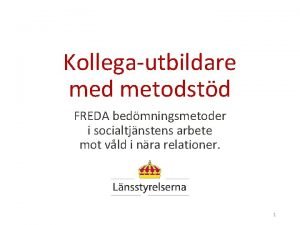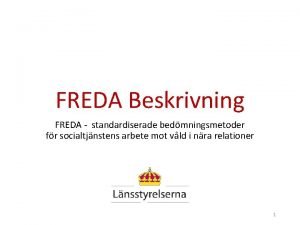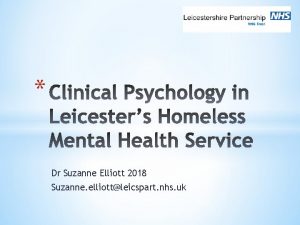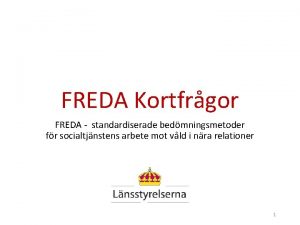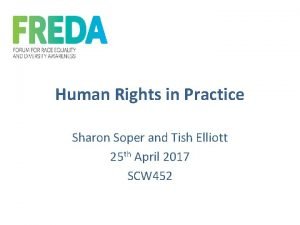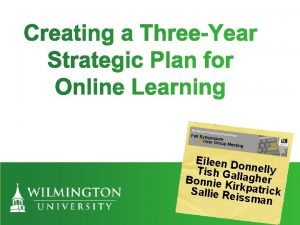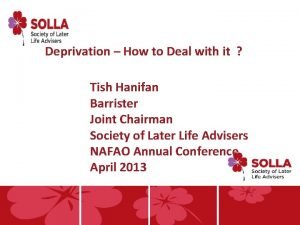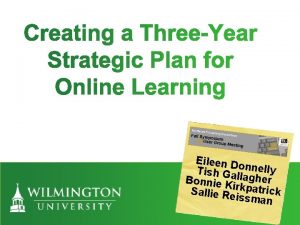FREDA Learning Together Event 2019 Tish Elliott Protecting






















- Slides: 22

FREDA Learning Together Event 2019 Tish Elliott: Protecting the Human rights of older LGBT+ people

Promoting the rights of older LGBT+ people FREDA Learning Together Event 2019 Proof of identity: LGBT+ Intersectionalities

Learning outcomes The focus of this part of today is promoting the rights of older LGBT+ people by: • exploring how intersectionality operates for older LGBT+ people • applying a rights-based approach in accordance with the Human Rights Act 1998 • upholding individual life choices when best interests decisions are made under the Mental Capacity Act 2005 • challenging discrimination on the grounds of protected characteristics under the Equality Act 2010 • promoting the wellbeing of older LGBT+ adults according to the Care Act 2014

“All human beings are born free and equal in dignity and rights” Article 1, Universal Declaration of Human Rights 1948

Rights-based practice Our role as practitioners in social care is to ensure that this fundamental principle and the entitlements outlined in human rights legislation are safeguarded for all (Elliott 2017) The Human Rights Act 1998 applies to everyone in the UK be they citizen or visitor, resident or non-resident.

A human rights approach to practice … is fully inclusive and avoids ‘othering’ because it works with the entitlements we all have and that we share as members of society, ensuring these are protected for all. Human rights are ‘universal, inherent and inalienable (cannot be forfeited)’. The Human Rights Act is unique in that it focuses on humanity, the basic freedoms and protections that every person has simply because they are human, as opposed to focussing on behaviour, needs or identity.

Political context – ongoing uncertainty • The government has previously stated that reform of the Human Rights Act will not be attempted during the period of exiting from the EU. • Leaving the EU does not automatically mean the UK will withdraw from the European Convention on Human Rights. • Discussions regarding a ‘British Bill of Human Rights’ to date have featured many of the rights enshrined in the HRA, and any future reform is likely to face substantial opposition.

What are our rights under the HRA? Right to life (Article 2) Right not to be tortured or treated in an inhuman or degrading way (Article 3) Right to be free from slavery or forced labour (Article 4) Right to liberty (Article 5) Right to respect for private and family life, home and correspondence (Article 8) Right to freedom of thought, conscience and religion (Article 9) Right to freedom of expression (Article 10) Right to a fair trial (Article 6) Right to freedom of assembly and association (Article 11) Right not to be punished for something that is not against the law (Article 7) Right to marry and found a family (Article 12) 8

Our human rights include the: Right to peaceful enjoyment of possessions (Article 1, Protocol 1) Right to education (Article 2, Protocol 1) Right to free elections (Article 3, Protocol 1) Abolition of the death penalty (Article 1, Protocol 13) Right not to be discriminated against in relation to any of the rights contained in the HRA (Article 14) Article 14 can only be invoked if another Article has breached the prohibition of discrimination. The EHRC provide hyperlinks giving further information on each Article https: //www. equalityhumanrights. com/en/human-rights-act 9

Can our rights be restricted? • Absolute rights can never be restricted. (This includes Articles 3, 4, 7) • Restricted rights are those which may have to be restricted, usually to protect the rights of others. • Restricted rights may be either Limited or Qualified • Human rights can only be restricted if this is lawful AND for a legitimate aim AND proportionate

Qualified rights • An example of a qualified right is the right to freedom of expression (Article 10). Our right to free speech may, for example, be restricted to protect someone else’s right to privacy (Article 8) • Or if you express views that encourage racial or religious hatred, a public authority may be allowed to restrict your freedom of expression. The right to hold particular beliefs cannot be restricted but the right to manifest these beliefs may be restricted • As with limited rights, the public authority must show that the restriction is ‘proportionate’ – no more than necessary to address the issue concerned. 11

When can a public authority interfere with a qualified right? It must show that it has a specific reason (legitimate aim) for interfering with your rights including: • protection of other people’s rights • national security • public safety • prevention of crime • protection of health The interference must be no more than is absolutely necessary to achieve one of the aims of the Human Rights Act.

Roger’s story https: //www. scie. org. uk/lgbtqi/video-stories/olderpeople-residential-care (SCIE video) Listen for any specific rights that are potentially being breached or protected in Roger’s story

CQC human rights approach to regulation

Rights-based and Outcomes-focused Care Services • Human rights provide the benchmark or minimum standard against which provision of services to all people can be judged. • Using a rights-based approach the focus moves from “a plethora of different approaches” to enabling all to have equal benefit with measurable outcomes in terms of human rights (brap 2010: 12).

Equality Act 2010 Provides legal protection against discrimination on the basis of the nine ‘protected characteristics’: • age religion or belief disability • sex pregnancy & maternity sexual orientation • race gender reassignment marital status

Promoting respect for diversity • People with a protected characteristic may be described as belonging to a particular discriminated against group though it is important not to assume that all members of a particular equality group have the same needs. • Intersectionality theory (Crenshaw, 2012) examines the potential for multiple oppression, in this instance that experienced by older people who are LGBT + and who are living with dementia.

Case study - Sue was diagnosed with a form of Alzheimer’s. She needed 24 hour care and eventually moved into a care home. She had no contact with family as they had rejected her when she transitioned from male to female earlier in her life. The care home managers became worried as she began to refer to herself as “Cliff” some of the time and she was distressed by her appearance at these times.

Working with Sue Which human rights do you think are relevant in Sue’s situation? What other legislation might apply? Taking a rights-based approach what might you do to promote Sue’s wellbeing?

Outcomes for Sue The social worker contacted Gay Advice Darlington/Durham who formed a partnership with Sue, Sue’s GP, social services and the care home. Care home staff also received training on trans identities which included the impact of stigma and mis-gendering, especially during periods of regression. This enabled more appropriate, empathic care and a significant improvement in Sue’s wellbeing and quality of life.

Useful resources Adult Social Care Outcomes Framework (ASCOF) LGBT Companion Document http: //lgbt. foundation/downloads/365 Hiding who I am – The reality of end of life care for LGBT people https: //www. mariecurie. org. uk/globalassets/media/documents/policypublications/june-2016/reality-end-of-life-care-lgbt-people. pdf Lesbian, Gay, Bisexual and Trans People and Dementia Project: Summary Report http: //dementiavoices. org. uk/wp-content/uploads/2015/03/Over-the-Rainbow. LGBTDementia-Report. pdf Out Loud - LGBT Voices in Health and Social Care: A narrative account of LGBT needs https: //nationallgbtpartnershipdotorg. files. wordpress. com/2016/05/np-out-loud-final. pdf Safe to be me - Meeting the needs of older lesbian, gay, bisexual and transgender people using health and social care services. A resource pack for professionals. https: //www. ageuk. org. uk/our-impact/programmes/safe-to-be-me/ Research in Practice for Adults open access website. Working with carers. Case Study Susan and Grace https: //carers. ripfa. org. uk/case-studies/case-study-3/

References brap (2010) Why bother with human rights? Birmingham: brap. http: //www. brap. org. uk/resources-publications-342/human-rights-publications-565 British Institute of Human Rights (2013) The Difference It Makes: Putting Human Rights at the Heart of Health and Social Care. London: BIHR. Care Quality Commission (2014) Human rights approach for our regulation of health and social care services Newcastle upon Tyne: CQC https: //www. cqc. org. uk/sites/default/files/20150416_our_human_rights_approach. pdf Crenshaw, K. (2012) On Intersectionality: The Essential Writings of Kimberlé Crenshaw. Perseus. Elliott T (2017) Leader’s Briefing: Embedding human rights in adult social care. Dartington: Research in Practice for Adults.
 Tish lopez
Tish lopez Rus psixologlari
Rus psixologlari Opvoedbelasting
Opvoedbelasting Freda karlo
Freda karlo Freda beskrivning
Freda beskrivning Freda farlighetsbedömning
Freda farlighetsbedömning Freda beskrivning
Freda beskrivning Qingyi (freda) song drechsler
Qingyi (freda) song drechsler Freda kortfrågor
Freda kortfrågor Simile for fish swimming
Simile for fish swimming He was a tornado blasting his way to the opposing team
He was a tornado blasting his way to the opposing team Freda wolfenden
Freda wolfenden Human rights freda
Human rights freda Freda walker
Freda walker Elliott erwitt biography
Elliott erwitt biography Yrdsb career cruising
Yrdsb career cruising Dana elliott
Dana elliott Pierre trudeau high school
Pierre trudeau high school Career cruising yrdsb
Career cruising yrdsb Dr elliott mayo clinic
Dr elliott mayo clinic Michael elliott md
Michael elliott md Dr suzanne elliott
Dr suzanne elliott Pierre elliott trudeau high school courses
Pierre elliott trudeau high school courses




